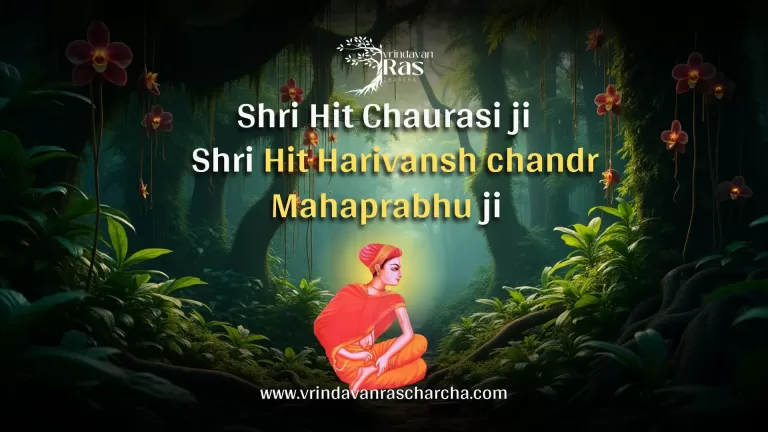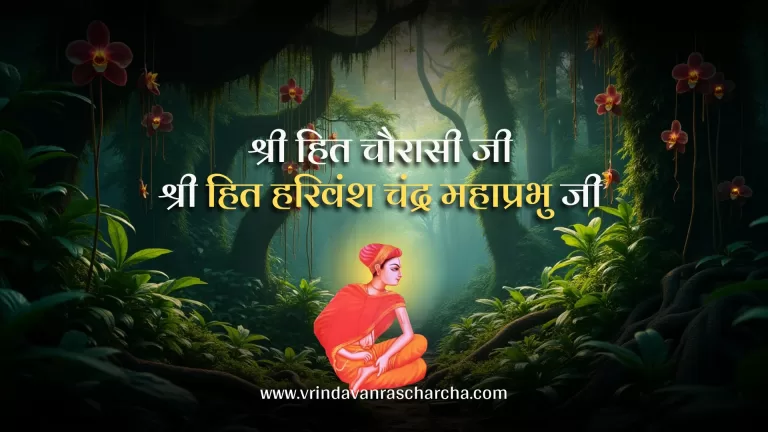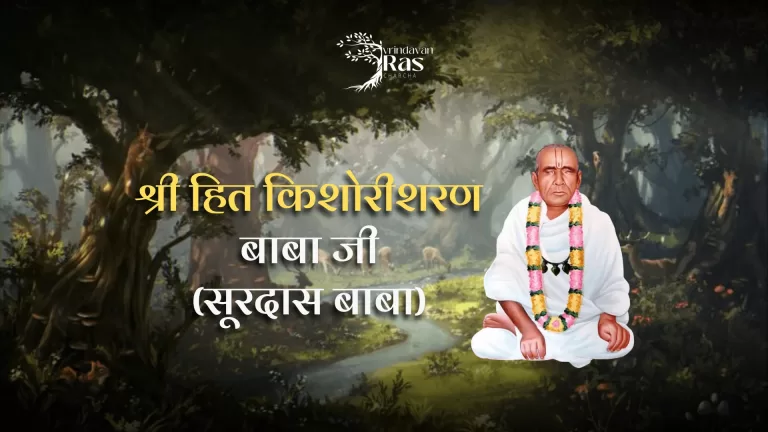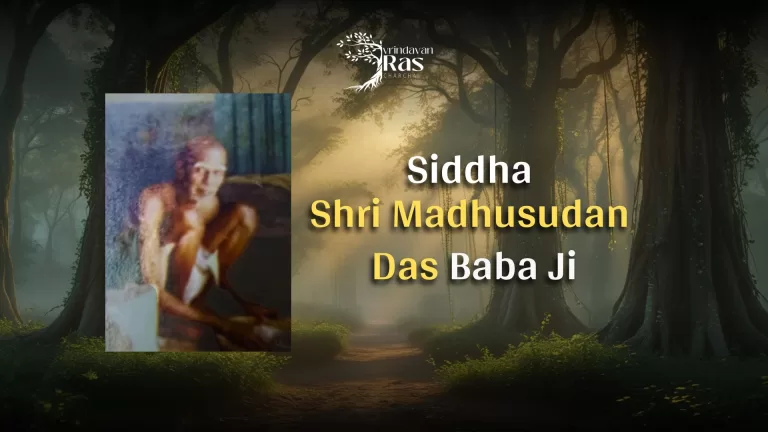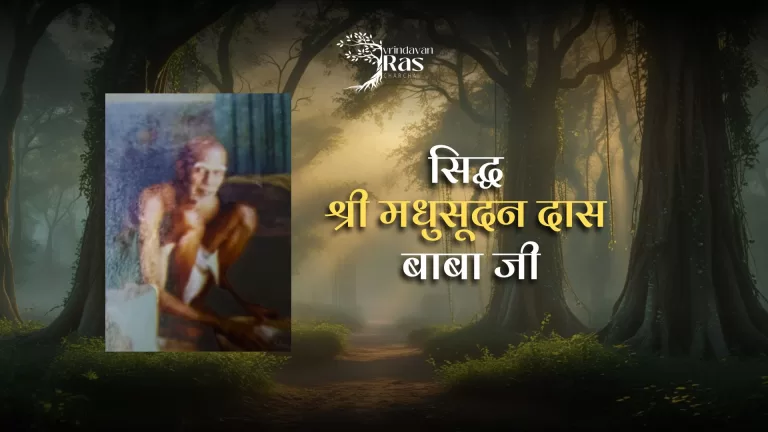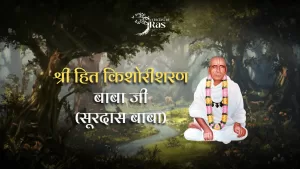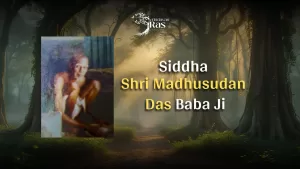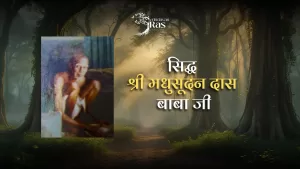Birth:
Goswami Shree Hita Roop Lal Ji Maharaj was born in the sacred lineage of Shree Hita Harivansh Ji Maharaj on Vaishakh Krishna Saptami, Samvat 1738 (1681 AD). His father was Shri Harilal Ji and mother was Shri Krishnakunwari Ji. From birth, his nature was deeply immersed in the divine love of Shri Radhavallabh.
Childhood of Shri Hita Roop Lal Ji Maharaj
At that time, due to the terror of foreign rulers, Shri Radhavallabh Lal Ji was hidden in Ajangarh near Kamavan. During the month of Shravan, when floods hit the area, young Roop Lal Ji suddenly insisted on having darshan of Shri Radhavallabh Ji. His father, compelled by his son’s spiritual longing, took him through the flood to Ajangarh.
Upon arrival, the child Shree Hita Roop Lal Ji entered a state of divine trance and began walking towards the temple. Since entry without initiation and ritual bath was forbidden, he jumped into the flooded Yamuna and declared, “I will take the bath myself!”
Moved by his faith and courage, his father performed a brief initiation and allowed him into the temple. There he embraced the feet of Shri Radhavallabh Ji and washed them with his tears of love.
The Mad Elephant’s Bow Before Roop Lal Ji
While passing through a narrow lane in Barsana during a palanquin journey, a mad elephant charged toward them. All the guards and carriers fled in fear. However, the elephant approached the palanquin and gently touched Shree Hita Roop Lal Ji’s feet with its trunk and walked away peacefully. Witnessing this miracle, people began to regard him as a divine soul.
Education and Marriage of Shree Roop Lal Ji
From childhood, he carried deep devotional impressions. He would joyfully sweep the Rasa Mandal with his own hands. After completing his education and marriage, at around the age of 20, he began spreading devotion across regions through constant travel.
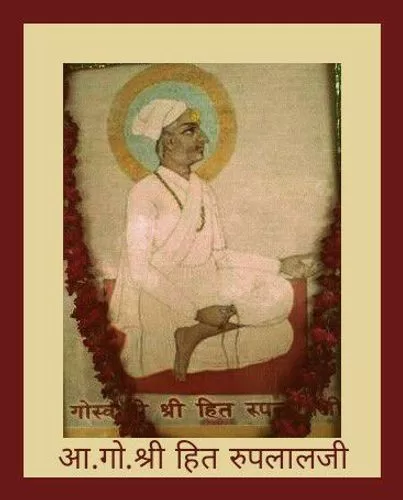
Dispute with Scholars and the King
Some Brahmin scholars of Braj questioned him, “Why do you not perform daily Sandhya rituals?”
He replied:
“The time of morning Sandhya is when Mangal Aarti is offered; midday Sandhya aligns with Rajbhog seva; and evening Sandhya coincides with the Lord’s awakening and seva. How can I forsake service for rituals?”
Though the scholars were embarrassed, they complained to King Jai Singh of Jaipur. The king summoned Shree Hita Roop Lal Ji and urged him to follow Vedic duties. But seeing them as a hindrance to seva, he declined. Angered, the king confiscated his property.
He then left Vrindavan with Shri Radhavallabh Ji and moved to Rohtak. The king there honored him and, after learning the whole story, defeated King Jai Singh and took over Kamavan, where he built a temple and established Shree Hita Roop Lal Ji as its head.
Construction of Shri Vrishabhanu Temple
His disciple Seva Sakhi Ji collected one lakh rupees from the king of Gonda and built a grand Shri Vrishabhanu Ji Temple in Barsana. The Radhashtami celebration was also established there, and this tradition continues under their lineage.
Pilgrimages and Miracles
During a pilgrimage to Gujarat, he stayed for eight months at the house of Shri Ramkrishna Mehta, whose deep devotion moved him. Through his grace, Mehta Ji received divine darshan of Shri Radha Krishna.
At Govind Kund, he worshipped a Giriraj Shila for six months, from which a beautiful Shri Yugal Kishor Vigraha manifested, now residing in Radha Kund.
In Prayag, a saint offered him a siddhi-giving coconut. He humbly returned it, saying, “For one seeking the grace of Shri Krishna, siddhis are meaningless.”
Miraculous Healing
On his return journey, in Agra, he healed the incurable illness of his disciple Vaishnav Dayaldas’s daughter, Vishnibai, through his divine mercy.
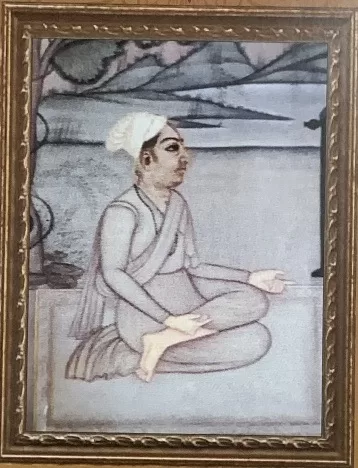
Darshan of Shri Radharani in Barsana
When he reached Barsana, Shri Radhakishori Ji, pleased with his love, gave him direct divine darshan. This divine event still inspires countless devotees.
Literary Contributions
He composed several poetic works in the Radhavallabhiya tradition, including:
- Pratham Vijay Chaurasi
- Dvitiya Vijay Chaurasi
- Ashtayam Seva Prabandha
- Manasi Seva Prabandha
- Nityavihar
- Gudh-Dhyan
- Braj-Bhakti
- Vani Vilas
- Sanjhi Leela
and other tradition also finds its roots in his compositions.
His writings are simple in language yet rich in vrindavan ras (emotion) and devotion.
Lineage of Disciples
His prominent disciples include Lal Murli Dhar, Kasturi Bai, Vrindavan Das Ji, Seva Sakhi Ji, Bhansakhi, and Kishoridas Ji.
Nikunja Entrance
In his final years, Shree Hita Roop Lal Ji resided in Barsana and immersed himself in the loving service of Shri Priya-Pritam. In Samvat 1818 (1750 AD), he entered Nikunja Lila, merging into the eternal service of the divine couple.


